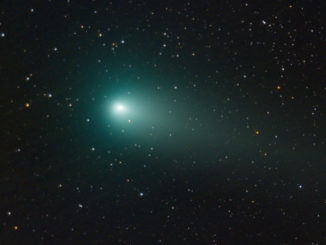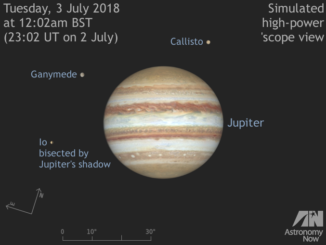
Galilean moon events for Io, Europa, Ganymede and Callisto

Great Red Spot (GRS)
This anticyclonic storm found just south of the planet’s South Equatorial Belt (SEB) has been observed for around four centuries. Although it is presently somewhat smaller than in recent years, the GRS presently makes up for that by taking on a distinctly reddish hue, making it easier to see in 3-inch (7.6cm) aperture telescopes, or larger.
The Great Red Spot is easiest to see when it crosses the imaginary line joining Jupiter’s north and south poles that passes through the centre of the planet’s disc. At such times we say that the GRS is ‘in transit’. For observers in the British Isles, conveniently observable transits of the Great Red Spot occur during May on the following dates and BST times: 10 (2:22am & 10:14pm), 12 (11:53pm), 15 (1:31am), 17 (11:01pm), 20 (12:40am), 22 (10:10pm), 24 (11:49pm), 29 (10:58pm).
You can obtain GRS predictions for yourself, in addition to phenomena of the Galilean moons Io, Europa, Ganymede and Callisto, for any given date or location in the world through our interactive online Almanac.
Note that the Almanac’s predictions of Jovian phenomena use 24-hour Universal Time (UT) — a global time reference based on the rotation of the Earth loosely synonymous with Greenwich Mean Time (GMT) that is one hour behind British Summer Time (BST) currently in force.
Always ensure that the Almanac’s Daylight Savings Time check-box is ticked if applicable to your date, time and location. For help using the Almanac, see this article.
Inside the magazine
Find out all you need to know about observing Jupiter and the other solar system bodies currently in the night sky in the May 2016 edition of Astronomy Now.
Never miss an issue by subscribing to the UK’s biggest astronomy magazine. Also available for iPad/iPhone and Android devices.




